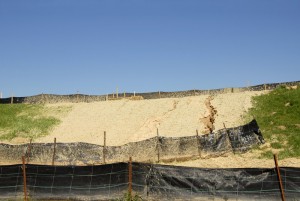
Sediment often escapes from pads that are not well-protected, and this much-wanted dirt is supposed to stay put to pass compaction or complete your building pads.
You can certainly put a silt fence up until the cows come home, and it will catch your sediment before it hits the streets, but what about the repairs that have to follow when you have gully and rill erosion to your recently graded and compacted building pad?
Erosion control is a vital element to sediment control; a kind of stop-it-before-it-starts approach.
Use Multiple BMPs for Sediment Control
To prevent violations to your General Storm Water Permit, perimeter sediment controls such as silt fence and straw wattle are essential to keeping sediment on your site.
Storm drain inlets should also have BMPs to prevent sediment from leaving your sight underground through the Storm Drain System. Properly installed BMPs can help prevent a good amount of discharge, but no one BMP is a prevent-all when it comes to dirt and water.
It’s always a good idea to have a combination of BMPs, products, and plans on hand should additional controls be needed.
Make BMP Adjustments as You Go
Best Management Practices are implemented by the Builder/Developer and designed by your Qualified SWPPP Developer.
The SWPPP is constantly changing at the job site as the project develops. Always remember that the sediment control plan for your grading phase will likely look much different from your vertical construction phase.
You will have to modify your BMPs as you go.

